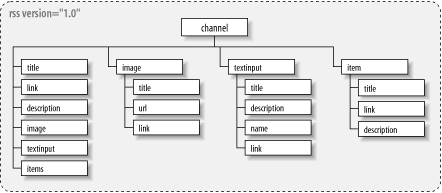RSS 1.0
XML technology. By adding RDF, namespaces, and modularization, RSS 1.0 both gives and takes away: what it loses in simplicity, it gains in extensibility and improved support for metadata. The Dublin Core metadata set is introduced at both the item level and the channel level. At the time of this writing there are over 14 additional sets of elements available as modules to the base specification, providing support for listing objects as diverse as streaming media and real-world events. Figure 3-4 shows a tree representation of RSS 1.0.

Figure 3-4. A tree representation of RSS 1.0
The Specification in Summary
XML-based, but in a more complex form than in previous versions.
RDF-based, providing much richer metadata.
Modularized, providing massive extensibility but also additional complexity.
Pull-based, but with features to allow Publish and Subscribe.
Example 3-4 is an example of RSS 1.0 using four optional modules.
Example 3-4. An example of RSS 1.0 using four optional modules
<?xml version="1.0" encoding="utf-8"?> <rdf:RDF xmlns:rdf="http://www.w3.org/1999/02/22-rdf-syntax-ns#" xmlns:dc="http://purl.org/dc/elements/1.1/" xmlns:sy="http://purl.org/rss/1.0/modules/syndication/" xmlns:co="http://purl.org/rss/1.0/modules/company/" xmlns:ti="http://purl.org/rss/1.0/modules/textinput/" xmlns="http://purl.org/rss/1.0/" > <channel rdf:about="http://meerkat.oreillynet.com/?_fl=rss1.0"> ...
Get Content Syndication with RSS now with the O’Reilly learning platform.
O’Reilly members experience books, live events, courses curated by job role, and more from O’Reilly and nearly 200 top publishers.

